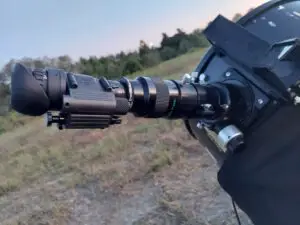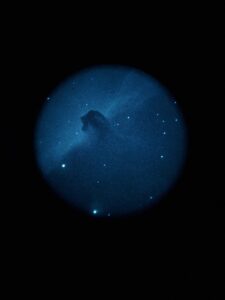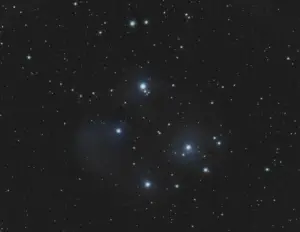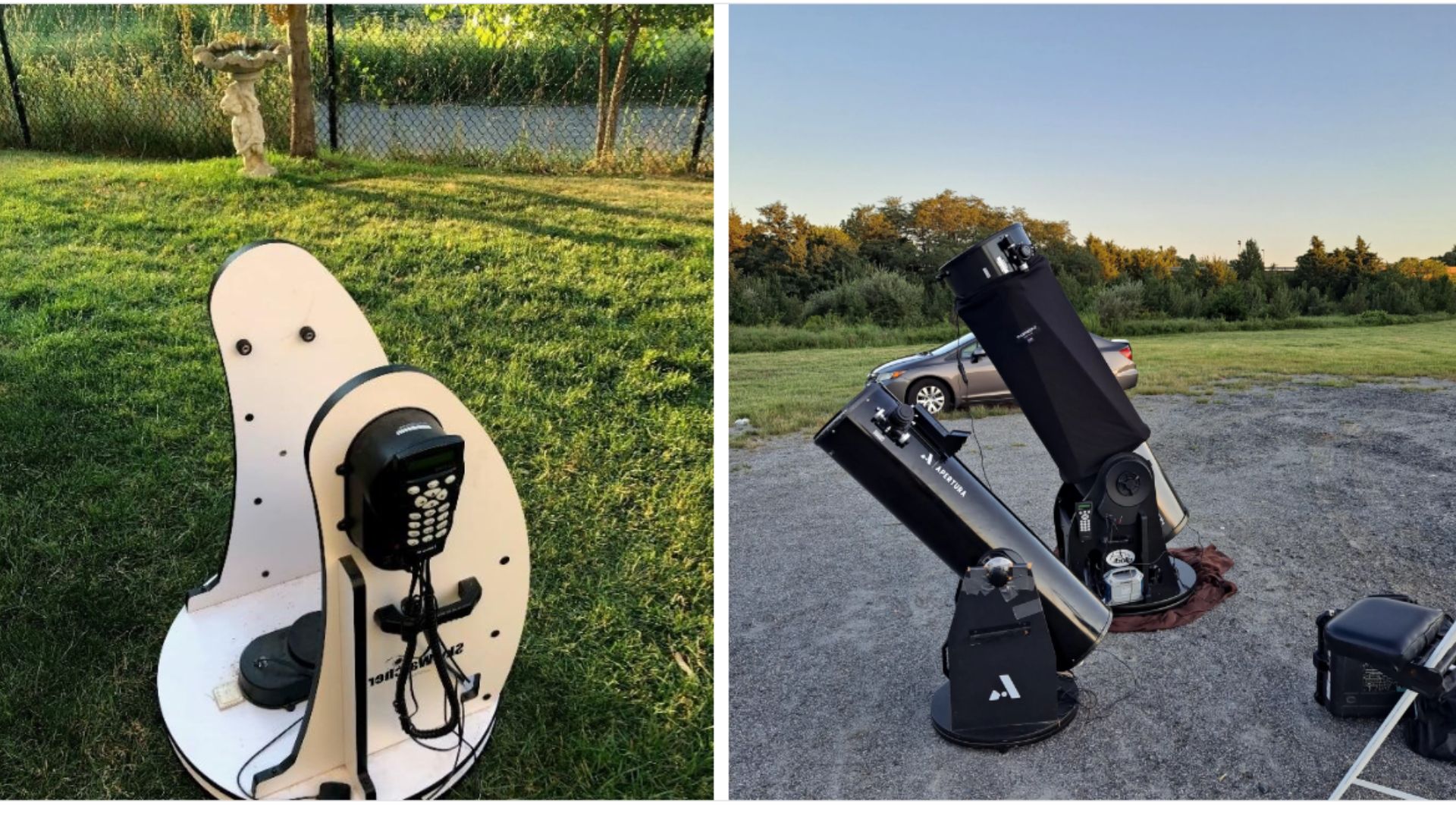The Dobsonian reflector is an immensely popular telescope among amateur astronomers. Powerful, cost-effective, and easy to use, they opened the door to large-aperture telescopes for observers across the world.
Since the early 2000s, GoTo models have become increasingly common from suppliers like Orion and Sky-Watcher.
These adaptations of the traditional Dob add motor drives to both axes to automatically slew the scope to any of thousands of targets in the computerized database and track the objects as they move across the sky due to Earth’s rotation.
Many purists insist that this upgrade is a waste of money which would be better spent on premium eyepieces or whatnot. I have owned and extensively used both manual and computerized Dobsonians, so I feel that I’m in a good position to judge for myself: Are GoTo Dobsonian telescopes worth it?
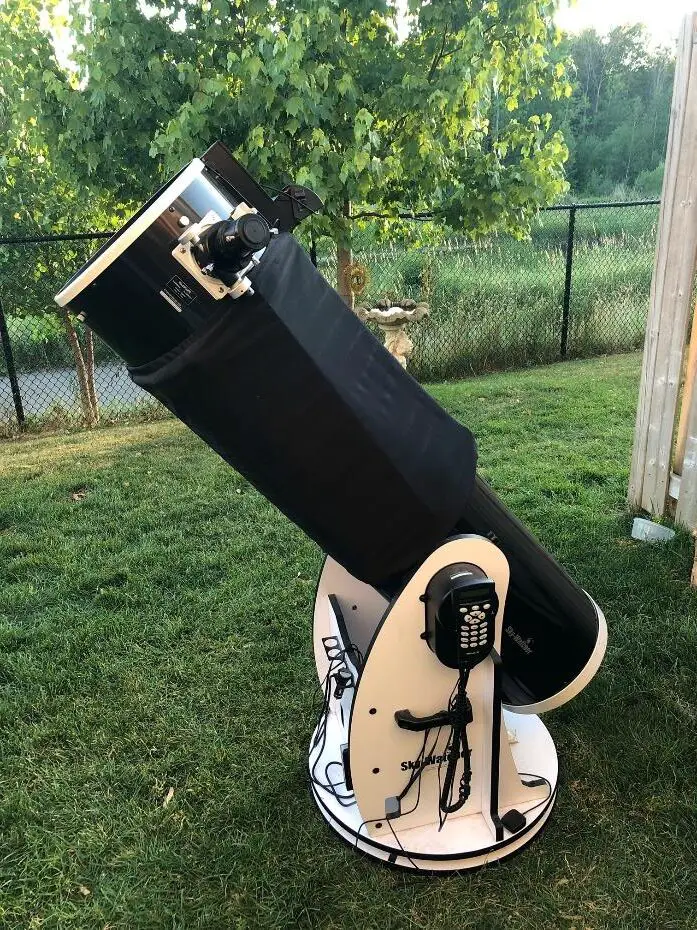
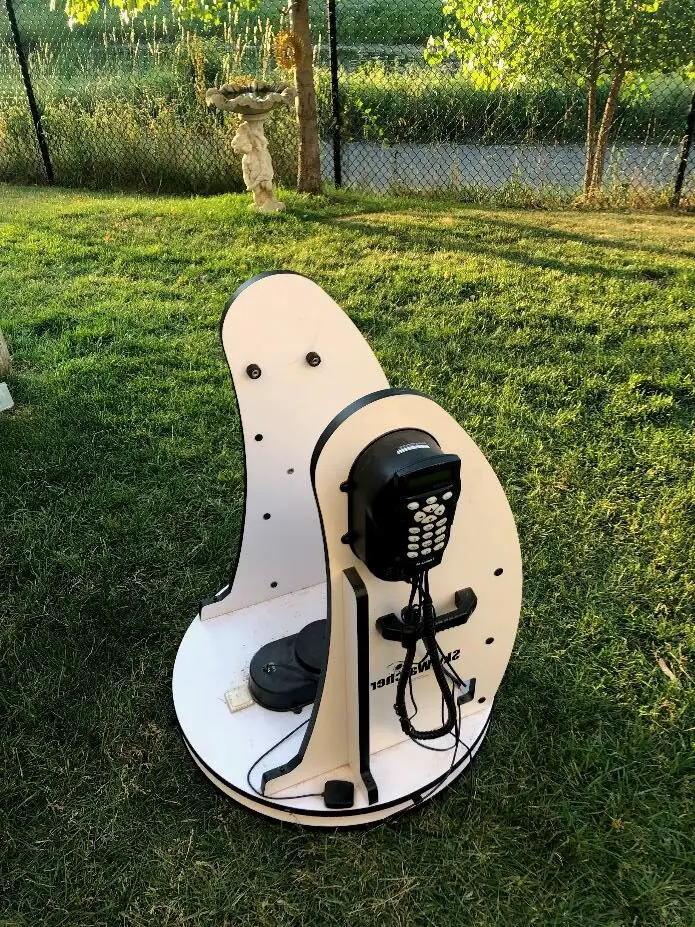
My Sky-Watcher 300P Synscan Dobsonian, before and after installing the optical tube assembly on the base. You can see the hand controller, two motor drives, and GPS dongle which are the key components to the GoTo system.
Advantages of a GoTo Dobsonian
A telescope like a Sky-Watcher Synscan Dobsonian or Orion XXg has several advantages over a more traditional Dobsonian:
Less time slewing, more time viewing
As much as I appreciated the thrill of the hunt with my old XT8 Classic, I enjoy viewing deep-sky objects a lot more than I enjoy searching for them.
Putting faint or hard-to-find objects within your reach
When searching for targets at the threshold of observability, it can be easy to overlook them when manually panning around the sky. If you align your GoTo well enough, it will put your target near the center of your field of view, so you’ll know whether to tick that object off the list or just move on to something a little brighter.
Easier viewing at high magnification
This is often overlooked but important. Having a Dob that can track objects means you can comfortably change eyepieces and refocus the telescope without worrying about your target scuttling away on you. Using magnifications over 300x is suddenly not so daunting.

Slow-motion panning
By using a low slewing speed, you can make fine adjustments to the position of your telescope. Putting a small target dead center is a cinch. Zoom in on the moon and then slowly pan around the surface; it feels as if you are hovering there in a spaceship!

Can be used manually
Sky-Watcher Synscan Dobs feature a “Freedom Find” system (dual encoders) which allows you to manually slew the telescope without messing up your alignment.
This is a wonderful feature to have, allowing you to do some old-fashioned star sweeping across the Milky Way in the middle of your observing session.
Also, if you find yourself with a dead battery, you can also use it as a traditional Dob, albeit with somewhat stiffer motions.
Astrophotography possibilities
Whether you are taking a cell phone snap of the moon or hooking up an astro-camera for deep sky photos, your task will be much easier if your telescope stays on target by itself. Note that you will still be limited to short exposures due to imprecise tracking and field rotation.
Great for outreach
Sharing the views through your telescope with the public can be exhilarating, but also frustrating. You will feel more relaxed and less rushed if you know your scope is tracking your target.
Disadvantages of a GoTo Dobsonian
As always, there are some trade-offs.
Cost
You’ve got to pay to play. GoTo functionality can more than double the cost of a telescope, and this can force you into choosing electronics over aperture. Consider than you can get a solid-tube 12” traditional Dob for around the same price as an 8” GoTo collapsible.
Additional set-up
While setting up a GoTo Dob isn’t difficult, it does take a bit longer and involve more parts than a manual telescope. But the extra time you spend will quickly be recouped during the observing session.
How to Set Up a GoTo Dobsonian
There’s no need to feel intimidated by the electronic aspect of GoTo telescopes. At the same time, you need to be aware that there is a bit of a learning curve. Here are the basic steps, once you have the scope assembled and collimated.
- Set date, time, and coordinates. You will only have good pointing accuracy if you enter this information correctly. Alternatively, you can add a GPS unit which will do this automatically or buy a model with built-in GPS. Note that you still need to perform a star alignment when GPS is activated.
- Perform star alignment. Most models have various options such as 1-star, 2-star, or brightest star alignment. The basic idea is to align the telescope with stars you can identify so that they computer can triangulate your precise orientation with the sky. This takes a few minutes at most.
- Select tracking rate. This step is not strictly necessary, but your scope will track better if you make sure the correct rate is selected. Use “sidereal” for planets, stars, and deep-sky objects; lunar and solar modes are self-explanatory.
And that’s it! Once you have performed these three steps accurately, your telescope will be ready to find and track thousands of objects.
What About Push-To Dobs?
A separate but related class of instrument, the Push-To Dobsonian like the Orion Intelliscope uses digital encoders to keep track of where your telescope is pointed. A handheld computer controller can then direct you to thousands of objects.
These telescopes have the same functionality of a traditional Dob but can save you time and frustration in searching for faint, elusive objects.
However, they cannot track objects and therefore miss out on one of the biggest advantages of the GoTo Dobsonian.
Push-To Dobs cost from 20% to 50% more than traditional Dobs.
Whether or not this is a good compromise between manual and computerized telescopes is a matter of preference.
From my point of view, I was happy to learn the sky on a completely manual Dobsonian before eventually making the switch to a full go-to system.
I’m not sure that a push-to system would have been useful enough to justify the extra cost, but many users seem happy with their investment.
At the time of writing this, the Orion Intelliscope seems to have been discontinued, but Celestron has introduced their Starsense Explorer series of Dobsonians, which use your smartphone attached to a docking station to guide the scope.
A cynical observer might point out that Celestron is charging quite a premium for these, considering the user must supply their own hand controller. But the concept still looks promising.
Conclusion
If you are keen on visual astronomy, a GoTo Dobsonian is a joy to use. Buying second hand can make the goal of owning such an instrument more attainable. I would stop well short of calling a GoTo Dobsonian a “must”, but they are certainly a lot of fun.
Keep in mind, however, that there is no replacement for education!
If you are thinking about buying a GoTo Dobsonian to avoid learning how to navigate the sky and how to operate a telescope, you will likely end up frustrated. Even with fancy electronics, astronomy is still a hobby where the rewards are proportional to the investment, not just in money but in time, effort, and interest.
I know more than a few people whose expensive GoTo telescopes haven’t even seen the first light after several years, because they can’t be bothered to put in the time to learn how to use them.
You know what they say about leading a horse to water. Putting the horse on a motorized platform still won’t make him any more likely to drink!

